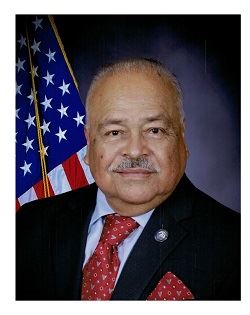Days before the county considers re-imposing an indoor mask-wearing mandate, Los Angeles County Supervisor Kathryn Barger Monday issued a public statement opposing such a move, saying she’s seen no hard evidence that such a requirement would curb the spread of COVID-19.
In an open letter sent to her Fifth District constituents, Barger said she believes “masking mandates are polarizing and unenforceable,” and said she does not believe such a move would have any major impact.
“I have not seen any empirical data that conclusively shows that masking mandates make a difference in decreasing or stopping COVID-19 transmission rates,” Barger wrote. “An analysis of Alameda County’s June 2022 masking mandate, in fact, concluded it had no significant impact in comparison to its surrounding counties that did not impose a masking mandate. Alameda County dropped this mandate after only three weeks.”
She added that a mandate “will not make a meaningful improvement to the underlying systemic healthcare inequities that are the true drivers of inequitable rates of COVID-19 deaths and long-term, negative effects.”
Barger’s comments come just days ahead of an anticipated Thursday decision on a possible new masking mandate for indoor public spaces in Los Angeles County. Public Health Director Barbara Ferrer has said that if the county remains in the “high” virus-activity level as defined by the U.S. Centers for Disease Control and Prevention for two consecutive weeks, the mask mandate would be re-imposed. The county is set to reach that two-week mark on Thursday, meaning the mandate would take effect Friday.
Ferrer indicated last week, however, that there might be a delay in imposing the mandate, depending on the trends in new COVID infections and hospitalizations. She noted during a Thursday media briefing that average daily case numbers appeared to be leveling off, and the number of people hospitalized dropped over the weekend.
She told reporters that if the county sees a “steep decline” in the case and hospital numbers, “we are likely to want to take a pause on moving too quickly on universal indoor masking.”
Los Angeles County moved into the CDC’s “high” level of COVID-19 community activity earlier this month, when the average daily rate of virus-related hospital admissions rose to 10.5 per 100,000 residents, surpassing the threshold of 10 per 100,000. On Thursday, Ferrer said the admission rate over the past week rose to 11.4 per 100,000.
On Friday, however, the county saw a sharp drop in the number of COVID- positive patients hospitalized in the county, with the figure dropping by about 80 people to reach 1,247. The number fell again on Saturday to an even 1,200. Updated figures were not immediately available on Monday.
Ferrer is expected to give an update Tuesday during the county Board of Supervisors meeting.
The county Monday reported 6,914 new infections from Saturday, 5,333 from Sunday and 3,072 on Monday. The county no longer reports case numbers on weekends, so it issues three-day totals on Mondays.
The new cases gave the county a cumulative total from throughout the pandemic of 3,268,588. The numbers reported by the county are believed to be an undercount, due to the wide use of at-home tests, the results of which are not always reported to health officials.
Another 33 deaths were also reported on Monday for the three-day reporting period, raising the overall virus-related death toll in the county to 32,637. The average daily rate of people testing positive for the virus was 14.3% as of Monday, down from roughly 16% last week.
Despite Barger’s doubt about the effectiveness of masks, Ferrer has repeatedly stressed during recent briefings that studies have proven that masks drive down transmission rates. She called mask-wearing an easy, “sensible” step that can protect against virus spread, particularly in indoor settings.
Barger said in her open statement Monday that she does not oppose mask-wearing, saying it “makes a lot of sense for individuals who want or need an extra layer of protection.”
“I support our current COVID-19 public health masking policies, which require their use while using public transportation, in hospitals, homeless shelters and jails. However, imposing a one-size-fits-all masking mandate now for all is not something I can or will support,” she wrote.
The Los Angeles County Business Federation, or BizFed, issued a statement last week also opposing a mask-wearing mandate, saying it will put an undue burden on small businesses that will have to enforce the requirement.
Although dozens of counties in California are also in the “high” virus-activity category, Los Angeles is the only one considering a mask mandate. Ferrer has acknowledged a lack of any formalized enforcement plan, saying the county relies primarily on education in hopes of convincing people to wear face coverings. She also said the county does not expect business owners to become enforcement agents.
“We rely heavily on people understanding why it’s important for us to add in this layer of protection at this point, and most people in the past have gone ahead and been compliant,” she said. “We’ll continue to work with everyone and make sure there’s good information.”
She noted that during previous mandates, very few businesses were cited for violations.
If a new mask mandate takes effect, it will remain in place until the county falls back to the “medium” virus-activity category for two weeks.
Masks are already still mandated in some indoor spaces — health care facilities, transit hubs, on transit vehicles, airports, correctional facilities and shelters. A universal mandate would spread the requirement to all indoor public spaces, including shared office spaces, manufacturing facilities, retail stores, indoor events, indoor restaurants and bars and schools.







